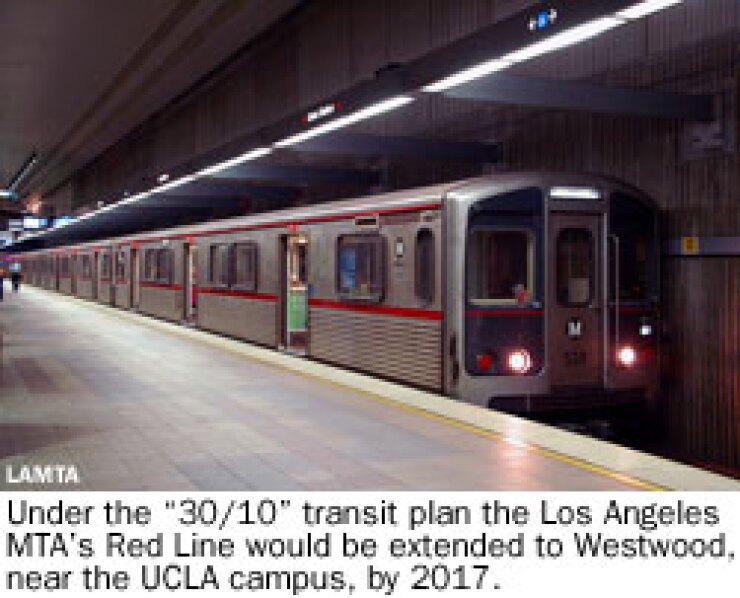
ALAMEDA, Calif. — Officials in the Los Angeles area say momentum is building behind a plan to accelerate construction of multiple transit projects — a plan that would require as-yet-uncreated forms of federal financial support.
Los Angeles Mayor Antonio Villaraigosa began to drum up support for the so-called 30/10 plan after Los Angeles County voters overwhelmingly approved a new half-cent sales tax for transportation projects.
Villaraigosa wants the 12 transit projects in the Los Angeles County Metropolitan Transportation Authority’s long-range 30-year plan built within a decade.
California transportation agencies like the LACMTA — better known as Metro — have a long history of accelerating capital construction projects by bonding against such voter-approved sales taxes.
The 30/10 plan requires a lot more capacity than can be generated by bonding against the Measure R sales tax using traditional tax-exempt bonds or Build America Bonds.
The Measure R tax is projected to generate $40 billion over its 30-year lifespan, of which 35% is dedicated to new rail transit projects.
The initiative includes all 12 transit projects that were advertised to voters in Measure R, including an extension of the Red Line subway to Westwood near the University of California Los Angeles campus.
The 30/10 plan projects that the 12 transit projects would require $13.7 billion from Metro, in year-of-expenditure dollars, if they are completed on the accelerated 10-year timetable.
Metro’s long-term plan projects that Measure R will only generate $5.8 billion for the transit projects over the next 10 years, and $13.1 billion over the entire 30 years.
Traditional bond financing will not work, because interest costs cut into the amount of money that can be put into the project, according to the staff report prepared for the Metro board of directors in April, when it formally endorsed the plan.
“30/10 contemplates federal assistance from an interest rate subsidy, loan guarantee, direct bridge loan, and-or creative repayment terms,” the report said.
The biggest request: a new category of debt, called transit improvement bonds, with a 100% interest subsidy.
“These TIBs could be enacted as part of a pilot program, through which the secretary of transportation would allocate bond issuance authority to state and local sponsors of nationally significant projects or programs of projects, such as 30/10,” according to Metro’s fact sheet on the subject.
The other federal leg Angelenos are counting on is a modification of the Transportation Infrastructure Finance and Innovation Act loan program.
They want to modify the TIFIA loan structure to allow the U.S. Department of Transportation to make an up-front credit commitment for, in Metro’s words, a “mega program” of related projects, like 30/10, that satisfies “national infrastructure investment goals.”
The 30/10 initiative will likely require about $200 million to fund the capital reserve of the $2.3 billion federal loan, according to Metro.
“30/10 doesn’t fit neatly into any existing federal infrastructure financing program, so an innovative funding package is needed. We’re not asking for a handout because we have local funds to pay back over time through a local-federal partnership,” Villaraigosa said last week at the U.S. Conference of Mayors meeting in Oklahoma City, where mayors voted to endorse the concept.
“Mayors from all around the country told me they see that 30/10 could be a national financing model to enable them to build and finance their own transportation projects,” he said.
Backers of the 30/10 plan say they have been getting a good response to their bold requests.
They clutch close to their hearts a letter U.S. Secretary of Transportation Ray LaHood wrote this month to Sen. Barbara Boxer, D-Calif.
“I share your belief that the 30/10 model — leveraging a comprehensive long-range transportation plan and a sustainable local funding stream — has the potential to transform the way we invest in transportation projects across the nation,” LaHood wrote.
“I can assure you that the U.S. Department of Transportation is committed to working with you to explore this promising approach in the next transportation reauthorization bill,” his letter said.
Los Angeles County Supervisor Zev Yaroslavsky, a member of Metro’s board, hailed LaHood’s letter, along with related news that the Federal Transit Administration decided to evaluate the entire proposed 9.3-mile extension of the Red Line subway as one integrated project, rather than three separate legs.
That makes the project more competitive when federal officials evaluate the request for the $2.1 billion in “New Starts” grant money the project needs in addition to the 30/10 funding, Yaroslavsky said in a news release.
That’s because the busiest station in the project is expected to be the terminal at Westwood, so cost-per-rider numbers are more compelling if it is included from the start, he said.
The accelerated plan could bring the Red Line to Westwood by 2017 — something not expected until 2036 under the current long-range plan.
“In other words, under the accelerated timetable, somebody who’s now in the fifth grade could be riding the subway to their freshman classes at UCLA — instead of waiting until long after they get their Ph.D.,” Yaroslavsky said.





